The Financial Health of Same-Sex Couples and LGBTQ Americans
2021's Lesbian, Gay, Bisexual, Transgender, and Queer (LGBTQ) Pride Month is the first to be officially recognized by a president since 2016 -- certainly cause for celebration! But this year's Pride Month also sees a collective holding of breath among the LGBTQ community.
At the time of this writing, the Supreme Court is expected to rule soon on Fulton vs. Philadelphia, a case that some pundits are saying could have big implications for LGBTQ healthcare access.
As we'll see below, same-sex couples already have fewer options for employer-provided healthcare, which can be a key element in establishing financial stability. But it's not just in healthcare access where same-sex couples and LGBTQ Americans struggle more than heterosexual individuals.
To recognize Pride Month 2021, we've gathered statistics from government agencies and private organizations to craft a picture of the financial health of same-sex couples and LGBTQ individuals in the United States. Read on to see where they outpace cis-straight citizens and where they fall behind.
Key findings
- On average, same-sex couples make $1,681 more than opposite-sex couples. This trend, however, is driven by male same-sex couples, who make $17,250 more than married opposite-sex couples, while female same-sex couples earned $9,643 less than married opposite-sex couples.
- LGBTQ Americans face significantly higher poverty rates than heterosexual Americans -- especially when it comes to trans individuals. 34% of trans men and 32% of trans women live in poverty, compared to 16% of cis-straight men and women.
- 33% of LBQ women have faced a personal financial crisis like declaring bankruptcy or not being able to pay bills. 24% of straight women, 23% of GBQ men, and 15% of straight men have gone through a crisis like this.
- Only 10% of non-LGBT households would be unable to cover an unexpected $400 expense, while 14.5% of LGBT households would struggle to cover it.
- 74% of employers that offer spousal benefits cover same-sex spouses, a notable increase from the 43% that did so in 2016, but still low enough to limit access for thousands of same-sex couples.
- LGBTQ Americans feel less prepared to make decisions that support their financial goals than the general population. For example, 43% of the general population of the United States feels able to make a wise decision about reducing or paying off personal debt, compared to 32% of LGBTQ Americans.
A note on LGBTQ financial statistics
Data on the financial health of same-sex couples is relatively sparse.
Most data collected by the Census Bureau, Federal Reserve, and other government entities isn't broken down by sexual orientation or non-binary gender identity. This makes it difficult to come up with a clear picture of the financial health of same-sex couples, which in turn can impact decisions made by employers and policymakers.
We hope to see more robust data collection in this space in the future.
Male same-sex couples make $17,250 more than married opposite-sex couples, but female same-sex couples make $9,643 less
Married opposite-sex couples make an average (median) of $96,932 per year, while same-sex couples average $98,613 (the Census Bureau doesn't say whether these same-sex couples are married or unmarried).
Male same-sex couples earn an average of $114,182, or $17,250 more than married opposite-sex couples. Female same-sex couples, however, earn $87,289 -- $9,643 less than opposite-sex couples
Female same-sex couples earned $26,893 less than male same-sex couples.
The gender pay gap is well documented, and female same-sex couples are proportionately affected.
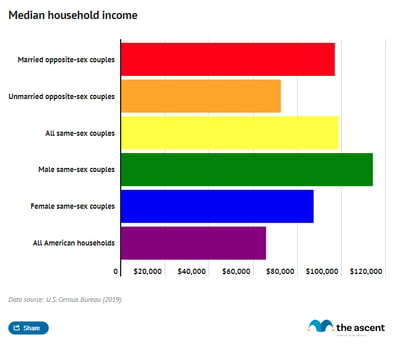
Married same-sex couples made roughly $20,000 more than unmarried same-sex couples, which follows a pattern also seen with opposite-sex couples.
| All married same-sex couples | Married female same-sex couples | Married male same-sex couples | All unmarried same-sex couples | Unmarried female same-sex couples | Unmarried male same-sex couples | |
|---|---|---|---|---|---|---|
| Median household income | $107,210 | $95,719 | $123,646 | $87,690 | $75,662 | $101,987 |
LBQ women make less than straight women, straight men, and GBQ men
The pay gap is starkest above the $75,000 annual income threshold. Just 25% of LBQ women make over $75,000 a year, compared to 32.2% of GBQ men, 32.5% of straight women, and 40.4% of straight men.
One factor that may drive the disparity in income between female same-sex couples and others is the fact that LBQ women, on average, make less money than straight women, straight men, and GBQ men.
| Annual income | LBQ women | Straight women | GBQ men | Straight men |
|---|---|---|---|---|
| Less than $10,000 | 7.70% | 5.50% | 5.60% | 4.00% |
| $10,000 to $14,999 | 6.90% | 5.10% | 5.20% | 3.80% |
| $15,000 to $19,999 | 10.10% | 7.90% | 8.00% | 6.10% |
| $20,000 to $24,999 | 11.70% | 9.80% | 9.90% | 8.00% |
| $25,000 to $34,999 | 11.70% | 10.80% | 10.80% | 9.40% |
| $35,000 to $49,999 | 13.40% | 13.40% | 13.40% | 12.70% |
| $50,000 to $74,999 | 13.50% | 15.00% | 15.00% | 15.70% |
| $75,000+ | 25.00% | 32.50% | 32.20% | 40.40% |
Race and ethnicity also affect LBQ women's pay. 32% of white LBQ women make over $75,000 per year, while only 17% of LBQ women of color make more than $75,000.
This reflects a larger trend in which white employees earn more than racial-minority employees.

Both partners of 62% of same-sex couples are employed, compared to 49% of married opposite-sex couples
49.4% of married opposite-sex couples include two people who are employed, while that number jumps to 62.3% for married same-sex couples.
Both partners are employed in 63.1% of married male same-sex couples, which may contribute to male same-sex couples earning more than both married opposite-sex couples and married female same-sex couples (61.6% of which see both partners employed).
Both partners of female same-sex couples are about as likely to be employed as both partners of male same-sex couples. However, female same-sex couples make significantly less than male same-sex couples and opposite-sex couples -- more evidence of the amplified gender wealth gap that female same-sex couples face.
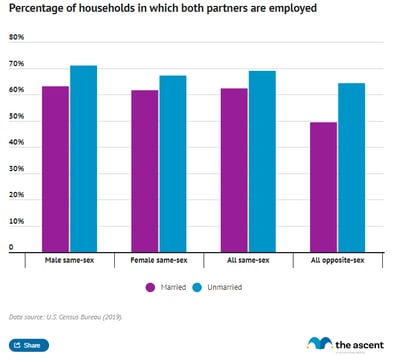
LGBT Americans were more likely than the general population to struggle financially or be unable to keep up with expenses in 2016
In 2016, 41% of LGBT Americans reported either struggling with finances or being unable to keep up with their bills. In contrast, only 27% of the general population (about 6% of whom identified as LGBT) reported the same.
Fortunately, the share of LGBT Americans who reported being in the best financial situation grew from 2% in 2012 to 15% -- nearly on par with the general population -- in 2016.
However, more LGBT Americans said they were making ends meet but struggling or unable to keep up with expenses in 2016 versus 2012.
Overall, the general population identified as faring better than the LGBT population. As we'll see, this may have many causes, from disparities in financial education to employer benefits to geography.
| LGBT Americans, 2012 | LGBT Americans, 2016 | General American population, 2016 | |
|---|---|---|---|
| I'm doing what I want, when I want, where I want | 2% | 15% | 16% |
| I'm not part of the 1%, but things are good | 20% | 11% | 18% |
| I'm living modestly, paying the bills and staying independent | 47% | 33% | 39% |
| I'm making ends meet, but it's a struggle | 25% | 33% | 23% |
| Unable to keep up with expenses | 6% | 8% | 4% |
LBQ women and GBQ men are more likely to have experienced a major personal financial crisis than straight men and women
A third of LBQ women have experienced a major personal financial crisis, compared to 24% of straight women, 23% of GBQ men, and 15% of straight men.
| Group | Have experienced a major personal financial crisis |
|---|---|
| LBQ women | 33% |
| Straight women | 24% |
| GBQ men | 23% |
| Straight men | 15% |
While the data doesn't include specifics on the cause of the financial crisis, the pattern fits with the common income patterns (LBQ women making less money than other groups) as well as lower availability of healthcare insurance and lower participation in life insurance among LGBTQ Americans than their cis-straight counterparts.
LGBT Americans are less prepared for future crises, too
According to the Center for LGTBQ Economic Advancement & Research (CLEAR), LGBT Americans are less likely to be prepared for a future emergency than non-LGBT Americans.
While 10% of non-LGBT households would be unable to cover an unexpected $400 expense, 14.5% of LGBT respondents said they wouldn't be able to cover one.
And whereas 25% of non-LGBT households wouldn't be able to come up with three months' worth of expenses with borrowing, savings, or selling assets, 36% of LGBT households wouldn't be able to cover the same amount of expenses.
Debt levels are fairly even among LGBT Americans and the general population
Despite being more likely to struggle financially, the LGBT population at large has very similar levels of debt to the general population.
This is one of the bright spots in this report, as large amounts of debt can have long-term consequences for both financial and mental health.
| LGBT Americans, 2012 | LGBT Americans, 2016 | General American population, 2016 | |
|---|---|---|---|
| Less than $10,000 in debt | 44% | 45% | 48% |
| $10,000 to $50,000 in debt | 37% | 34% | 32% |
| More than $50,000 in debt | 19% | 21% | 20% |
However, this fact belies the severe income disparity among LGBTQ women and their cis-straight peers, which could lead to significant debt problems in the future.
LGBT Americans have a poverty rate of 22% compared to a rate of 16% in cisgender straight Americans
15.7% of cis-straight Americans live in poverty, while LGBT Americans have a poverty rate of 21.6%. The transgender population has an even higher poverty rate at 29.4%.
This data indicates that a financial wellbeing gap exists for LBQ women. Cisgender men have the lowest poverty rates among Americans, while women generally experience a higher poverty rate. Transgender Americans and cis-bisexual women have the highest poverty rates.
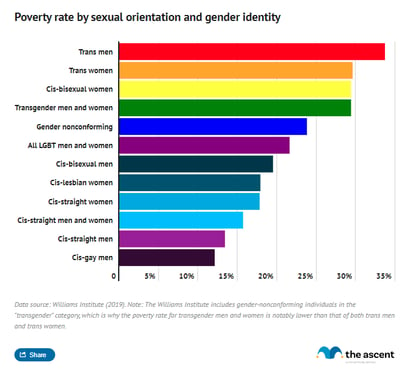
Geography may play a role here.
Many same-sex couples and LGBT Americans choose to live in large cities that are generally seen as more LGBT-friendly. Places like San Francisco, Portland, Austin, and Washington, D.C. are some of the most socially conscious cities in the country and have higher LGBT population density than other cities -- but they tend to have a very high cost of living, as well.
Keep in mind that many national measures of poverty don't take into account cost of living in a particular city and only look at salary. But the same salary won't go nearly as far in San Francisco as it will in Omaha.
LGBT racial minorities face significantly higher poverty rates than white LGBT Americans
Poverty rates tend to be higher for LGBT racial minorities compared to their cisgender, straight, same-race counterparts.
| Race/ethnicity | LGBT poverty rate | Cis-straight poverty rate | Difference |
|---|---|---|---|
| Hispanic | 37.3% | 38.0% | –0.70% |
| American Indian or Alaska Native | 32.4% | 26.9% | 6.5% |
| Black | 30.8% | 25.3% | 5.5% |
| Native Hawaiian or Pacific Islander | 28.9% | 25.4% | 3.5% |
| Asian | 22.9% | 14.6% | 8.3% |
| White | 15.4% | 9.1% | 6.3% |
| Other race | 42.1% | 14.8% | 27.3% |
| Multirace | 22.3% | 20.8% | 1.5% |
LGBT Americans are almost twice as likely as non-LGBT Americans to have "poor" or "very poor" credit
According to a 2021 report from the Center for LGBTQ Economic Advancement & Research, 16% of LGBT Americans report having a "poor" or "very poor" credit score compared to 8% of non-LGBT respondents.
Because a good credit score is required for many high-quality financial products from credit cards to mortgages, this problem is one that may perpetuate itself.

Only 74% of employers that offer spousal benefits include same-sex spouses
95% of employers offer health insurance that an employee's spouse can join, but coverage for same-sex spouses is lagging.
Only 74% of employers offered same-sex spousal health benefits in 2020 (though that's an improvement from 43% in 2016).
Healthcare can be expensive -- especially without insurance. A single medical bill can derail years of financial planning. The ability to obtain health insurance is a crucial component of financial wellbeing.
| 2016 | 2017 | 2018 | 2020 | |
|---|---|---|---|---|
| Employers offering spousal benefits that cover same-sex spouses | 43% | 57% | 63% | 74% |
| Employers offering spousal benefits that don't cover same-sex spouses | 16% | 11% | 6% | 5% |
| Not encountered* | 41% | 31% | 31% | 21% |
However, among employees that work at employers that offer opposite-sex spousal benefits, 91% of employees had access to same-sex spousal benefits, a slight increase from 84% in 2016.
Smaller employers are less likely to offer spousal benefits that cover same-sex spouses. 95% of employers with 1,000 or more workers offered spousal benefits to same-sex spouses compared to 73% of employers with 3–49 workers.
| Employers with 3–49 workers | Employers with 50–199 workers | Employers with 200–299 workers | Employers with 1,000 or more workers | All employers | |
|---|---|---|---|---|---|
| Companies offering spousal benefits that cover same-sex spouses | 73% | 76% | 87% | 95% | 74% |
| Companies offering spousal benefits that don't cover same-sex spouses | 4% | 18% | 11% | 5% | 5% |
| Not applicable/not encountered* | 23% | 6% | 2% | 0% | 21% |
While there are numerous factors that govern whether a household has access to health insurance, employer provision of that insurance is a crucial one. This is likely one of the factors that drives lower healthcare insurance participation among LGBT households.
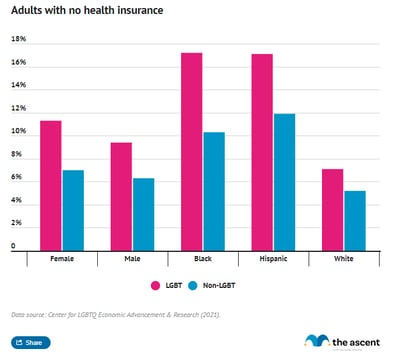
Over one-quarter of LGBT households are un- or underbanked
While 18% of non-LGBT households in American are unbanked or underbanked, almost one in five (23%) LGBT households find themselves in that situation.
(CLEAR defines "unbanked" as not having a checking, savings or money market account; "underbanked" means a household has at least one bank account but used one or more alternative financial services in the past year.)
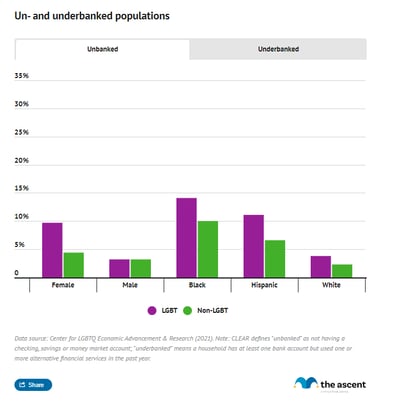
LGBT Americans lag the general population in use of most financial products
In 2016, a Prudential survey found that 47% of the general American population had a savings account, while only 40% of LGBT Americans had one.
Financial products like brokerage accounts, savings accounts, retirement accounts, and insurance offerings are the building blocks of financial wellbeing. The fact that LGBT Americans had lower rates of usage among almost every financial product listed is worrying.
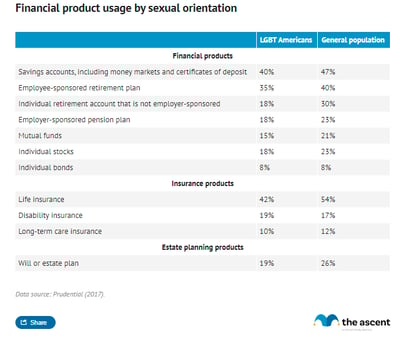
It's unclear why LGBT Americans show lower numbers in these financial products, and we'd like to see research organizations dig deeper into this issue in the future.
LGBT Americans allocate 20% of their income to retirement and other growth accounts, 5% less than the general population
In 2016, LGBT Americans reported putting 20% of their income towards "retirement , accounts intended to grow, or accounts with quick access," while the general population put 25% of their income into those accounts.
That LGBT Americans and the general population were able to put more money towards retirement, investments, and other accounts than towards debt, loans, or discretionary spending is a positive sign.
Both LGBT Americans and the general population want to bump up their investment into those accounts, an aspiration that we like to see. Investing and staying the course for the long run is a bedrock principle of financial health.
| Spending category | Current allocation, LGBT Americans | Current allocation, general population | Ideal allocation, LGBT Americans | Ideal allocation, general population |
|---|---|---|---|---|
| Necessities | 51% | 47% | 34% | 32% |
| Debt or loans | 15% | 14% | 10% | 8% |
| Discretionary | 14% | 14% | 21% | 21% |
| Retirement, other accounts intended to grow, or accounts with quick access | 20% | 25% | 35% | 39% |
The disparity in growth account contribution makes itself seen in total household savings. CLEAR's 2021 report shows that non-LGBT households are more likely than LGBT household to have saved $50,000 or more.
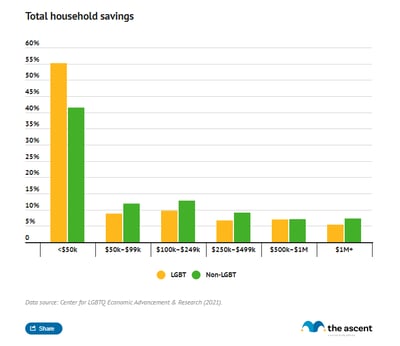
LGBT Americans feel less prepared to make wise decisions in support of their financial goals than the general population
On average, 34% of the general American population feels prepared to make wise financial decisions related to important issues. In contrast, only 24% of LGBT Americans feel prepared to make those same wise decisions.
Data collected by Prudential reveals that most Americans don’t feel prepared to make wise decisions with regard to their most important financial goals. Across all goals, LGBT Americans felt less prepared than the general population to make the best decision.
| Being financially independent/Not being a financial burden | Having enough savings to last my lifetime | Building or growing an "emergency savings" account | Reducing/paying off my personal debt | Maintaining a standard of living for my family in the event that something were to happen to me | |
|---|---|---|---|---|---|
| Consider very important (all) | 76% | 71% | 61% | 58% | 59% |
| General population very well prepared to make wise decisions related to topic | 35% | 28% | 34% | 43% | 31% |
| LGBT Americans very well prepared to make wise decisions related to topic | 25% | 18% | 24% | 32% | 22% |
Why do LGBT Americans feel so much less prepared than the general population? Lee Badgett, Professor of Economics at UMass-Amherst and author of The Economic Case for LGBT Equality: Why Fair and Equal Treatment Benefits Us All, points out that "LGBT people are younger and might not have the same assets, income, and knowledge on average because of that."
"Overall, the research suggests to me that financial education targeted at LGBT people is necessary," continues Badgett. "Having programs that acknowledge and empower LGBT people to recognize and push back on unfair treatment in labor markets and credit markets might help them more than general types of financial education."
Not being able to get health insurance for a same-sex spouse, dealing with lower annual income, and uncertainty around issues like life insurance may also contribute to the LGBTQ population's feeling of being less prepared.
Roughly 70% of straight men and women own homes compared to about 60% of LBQ women and GBQ men
Homeownership is associated with (although not causally linked to) stronger financial wellbeing, according to research from the Consumer Financial Protection Bureau.
Unfortunately, a gap between LGBT and straight Americans persists in homeownership.
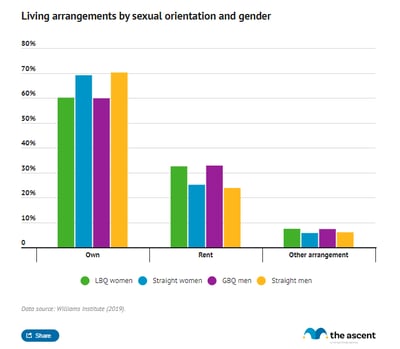
We don't have data on why homeownership is lower among LGBTQ Americans, but Professor Badgett references "recent studies that show same-sex couples experience discrimination in the credit market for mortgages."
We also know that housing is very expensive in the cities that have larger LGBTQ populations. Places like San Francisco and Washington, D.C. have significantly higher housing prices than other locations, and this makes it harder for everyone to buy a home.
LGBTQ finance has improved, but still has far to go
Based on the data available, same-sex couples and LGBT Americans are more likely to face some financial hardships -- like poverty, personal financial crisis, or struggling to keep up with bills -- than opposite-sex couples and straight Americans.
Gender and race can amplify those hardships and create disparities within the LGBT population. For example, male same-sex couples have the highest average income among same and opposite-sex couples, while female same-sex couples have the lowest income. And white LBQ women face lower poverty rates than LBQ women of color.
And while LGBT Americans lag the general population in the use of financial tools and confidence in having the knowledge to make the best financial decisions to reach their goals, the data shows that both groups have ample room to improve their utilization of financial products and build their financial knowledge.
There are some bright spots. The percentage of LGBT Americans that reported a higher level of financial freedom grew from 2012 to 2016 to be nearly on par with the general population. LGBT Americans don’t carry higher levels of debt than the general population, and they have aspirations to invest and save more.
Achieving financial wellbeing can seem daunting, especially for LGBT Americans that can face unique hurdles, including workplace discrimination. The Motley Fool is committed to helping all individuals improve their financial health and becoming smarter, happier, and richer. Whether you’re thinking about taking your first steps towards a brighter financial future or looking for guidance on a major financial decision, The Motley Fool and the Ascent have resources to help and are on your team.
Sources
- Center for LGBTQ Economic Advancement & Research (2021). "The Economic Well-Being of LGBT Adults in the U.S. in 2019."
- Consumer Financial Protection Bureau (2017). "Financial Wellbeing in America."
- Kaiser Family Foundation (2020). “Access to Employer-Sponsored Health Coverage for Same-Sex Spouses: 2020 Update.”
- Prudential (2017). "The LGBT Financial Experience."
- U.S. Census Bureau (2019). "Characteristics of Same-Sex Couple Households: 2005 to Present."
- UCLA School of Law Williams Institute (2021). "Health and Socioeconomic Well-Being of LBQ Women in the US."
- UCLA School of Law Williams Institute (2019). "LGBT Poverty in the United States: A study of differences between sexual orientation and gender identity groups."
Our Research Expert
We're firm believers in the Golden Rule, which is why editorial opinions are ours alone and have not been previously reviewed, approved, or endorsed by included advertisers. The Ascent, a Motley Fool service, does not cover all offers on the market. The Ascent has a dedicated team of editors and analysts focused on personal finance, and they follow the same set of publishing standards and editorial integrity while maintaining professional separation from the analysts and editors on other Motley Fool brands. The Motley Fool has a Disclosure Policy. The Author and/or The Motley Fool may have an interest in companies mentioned.